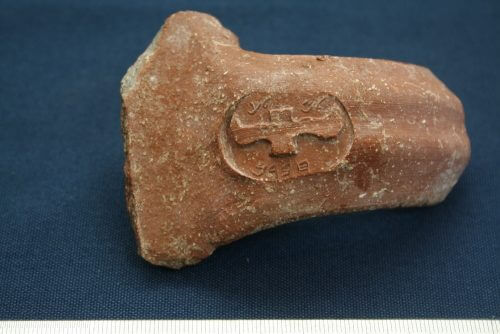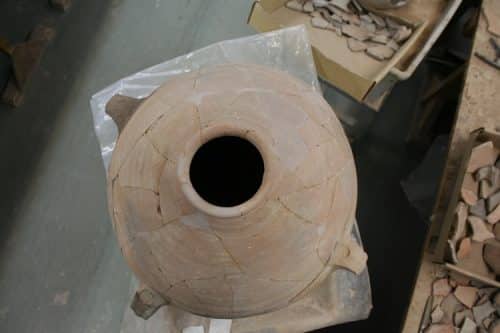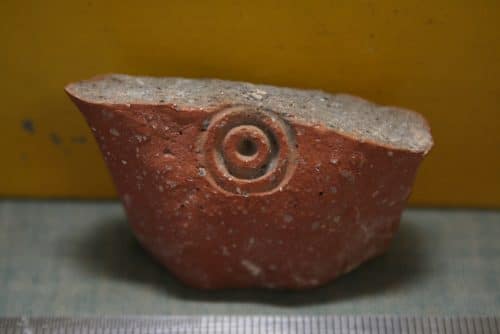With the help of "King" jars from the Kingdom of Judah, archaeologists and geophysicists were able to reconstruct the strength of the ancient magnetic field. Dr. Erez Ben Yosef from Tel Aviv University: "The significance of the discovery is that the magnetic field that protects the Earth from radiation is not in danger of collapsing."

The weakening of the Earth's magnetic field is not a new phenomenon, and there is no reason to assume that it indicates the reversal of the poles. This is according to a new multidisciplinary study, which examined dozens of jugs from the days of the Kingdom of Judah, between the 8th and 2nd centuries BC.
The research was conducted by Dr. Erez Ben Yosef, Prof. Oded Lipshitz and the research student, Mike Millman from the Department of Archeology at Tel Aviv University and Dr. Ron Shaar from the Hebrew University in Jerusalem, in collaboration with the Scripps Magnetic Laboratory in San Diego, USA. The results of the research are published today in the prestigious journal PNAS.
"It is the magnetic field that enables the existence of life on Earth as we know it," says Dr. Erez Ben Yosef. "This field protects us from cosmic radiation and the solar wind, it is used by many animals for navigation and it directly affects many other processes in nature, such as the production of isotopes in the atmosphere. Despite this, the Earth's magnetic field was and remains a scientific puzzle in which the hidden outweighs the visible. Albert Einstein defined understanding the origin of the field as one of the five most important mysteries in physics."
According to the accepted theory, the magnetic field is created in the outer core of the earth, at a depth of more than 2900 km and at a temperature of more than 4000 degrees. The core consists mostly of liquid iron. The movement of the iron, which is an electrically conductive material, produces a magnetic field as a result of the Earth's rotation around its axis. Since the middle of the 19th century, direct measurements of the strength of the field have been conducted - but these measurements indicate its weakening.
"Since the measurements began, the Earth has lost about 10% of its magnetic field," explains Dr. Ben Yosef. "In addition, we know that the weakening of the intensity is related to the rare phenomenon of the reversal of the poles. The field weakens to almost zero during the reversal of the magnetic poles, and some researchers see the current decrease in strength as the beginning of such a reversal. The reversal itself worries quite a few people and feeds quite a few conspiracy theories. Although most scientists think that there will be no catastrophe even in the case of the reversal of the poles, but there are a number of researchers who believe that we will not be able to exist without a magnetic field. Obviously, all these questions lead to the question of the strength of the magnetic field in the past, before the measurements began."

To measure the ancient magnetic field, geological or archaeological materials must be used, which "recorded" the ancient magnetic field at the time of their formation. These materials, like basalts for example, contain magnetic particles that aligned according to the magnetic field while the material cooled. In general, archaeological finds such as pottery, bricks, roof tiles and kilns allow a more accurate source than geological materials for the strength of the magnetic field in the 10,000 years that have passed since man learned to use fire.
"In the current study, we used the basic archaeological research conducted on the ancient Kingdom of Judah," says Dr. Ben Yosef. "From the eighth century to the second century BC, an organized bureaucratic system operated in Judah, which used to stamp the handles of the storage jars with various administrative seals, such as the seal 'for the king'. These seals allow us to match an exact date to the strength of the field recorded in the jars, with an accuracy of up to a few decades, thus reconstructing 600 years of an ancient magnetic field - a database unprecedented in scope."
The researchers sent the "King" jars of the Kingdom of Judah to the magnetic laboratory of Prof. Lisa Tokes at the Scripps Institute in San Diego. The results obtained show that there is no reason to fear the weakening of the magnetic field nowadays, since it weakened much more in the recent past - and "recovered" afterwards.

"From the jars we learn that the strength of the magnetic field has decreased by 20% in 30 years, so the weakening of the magnetic field by 10% over the past 180 years should not be of particular concern, explains Dr. Ben Yosef, "This research teaches us that the field fluctuates. In fact, the new findings strengthen previous findings, which we published in 2009, indicating that 3,000 years ago the strength of the magnetic field was 2.5 times stronger than it is today - the strongest field in the history of the Earth, a phenomenon we call The Iron Age Geomagnetic Spike."
In addition to the new database's contribution to understanding the Earth's magnetic field, the researchers hope it will also contribute to a better understanding of local archaeology. "It's a two-way window of understanding. We can take a jar from 630 BC, measure its magnetic properties and thus reconstruct the strength of the Earth's ancient magnetic field - or we can take a jar whose age we do not know, and use the ancient magnetic field to date it. Our vision is to establish a database on the ancient magnetic field that will be another tool for archaeological dating in our region, similar to carbon 14 dating."

2 תגובות
A. Ben Ner
There is a very small effect of the Earth's magnetic field on the climate. Strong evidence for this is that there is no distinct climate change during the times of the magnetic field reversal.
Of course the question arises,
Is there a connection between the decrease in the strength of the Earth's magnetic field, and the increase in the temperature of the atmosphere?
It seems that the connection exists. The decrease in the strength of the magnetic field allows many energetic particles to pass through
the cosmic radiation and the solar wind, to penetrate the atmosphere. These energetic particles are slowed down in the atmosphere
and raise her temperature.
In addition, it is possible that the impact of cosmic particles on nitrogen atoms in the atmosphere, causes the creation
Carbon and oxygen atoms that create the greenhouse gas CO2 that also causes the temperature of the atmosphere to rise.